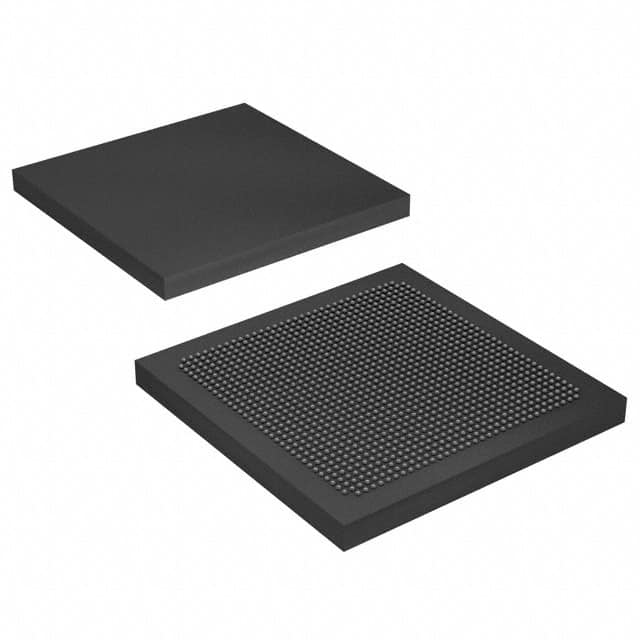Lihat spesifikasi untuk detail produk.

EP3SL150F1152C4
Product Overview
Category: Programmable Logic Device (PLD)
Use: The EP3SL150F1152C4 is a high-performance PLD designed for various applications in the field of digital logic design. It offers flexible programmability and advanced features, making it suitable for a wide range of projects.
Characteristics: - High-speed operation - Large capacity - Low power consumption - Versatile I/O options - Robust packaging
Package: The EP3SL150F1152C4 comes in a compact and durable package, ensuring protection during transportation and handling. The package includes the PLD chip, user manual, and necessary documentation.
Essence: This PLD is built to provide designers with a powerful tool for implementing complex digital logic circuits. Its programmable nature allows for customization and adaptability, making it an essential component in modern electronic systems.
Packaging/Quantity: The EP3SL150F1152C4 is available in trays or reels, depending on the quantity ordered. Each tray/reel contains a specified number of PLD units, ensuring easy integration into production processes.
Specifications
- Logic Elements: 150,000
- Embedded Memory: 1,152 Kbits
- Maximum User I/Os: 622
- Operating Voltage: 1.2V
- Operating Temperature Range: -40°C to 100°C
- Package Type: FineLine BGA
- Package Pins: 1152
Detailed Pin Configuration
The EP3SL150F1152C4 has a comprehensive pin configuration that enables seamless connectivity with external components. Here are some key pins:
- VCCIO: Power supply pin for I/O banks.
- GND: Ground reference pin.
- JTAG_TCK: Test clock input for JTAG boundary scan.
- JTAG_TMS: Test mode select input for JTAG boundary scan.
- CLKIN1: Input clock pin 1.
- CLKOUT0: Output clock pin 0.
For a complete pin configuration diagram, please refer to the official documentation provided by the manufacturer.
Functional Features
The EP3SL150F1152C4 offers several functional features that enhance its usability and performance:
Flexible Programmability: The PLD can be programmed using industry-standard hardware description languages (HDLs) such as VHDL or Verilog, allowing designers to implement custom logic functions.
High-Speed Operation: With advanced architecture and optimized circuitry, the PLD delivers high-speed operation, making it suitable for applications requiring real-time processing.
Embedded Memory: The integrated memory blocks provide additional storage capacity, enabling the implementation of complex algorithms and data processing tasks.
Versatile I/O Options: The PLD supports a wide range of I/O standards, including LVCMOS, LVTTL, and differential signaling, ensuring compatibility with various external devices.
Advantages and Disadvantages
Advantages: - High-performance capabilities - Flexible and customizable design - Low power consumption - Extensive I/O options - Robust packaging for protection
Disadvantages: - Relatively higher cost compared to simpler logic devices - Steeper learning curve for programming and utilization
Working Principles
The EP3SL150F1152C4 operates based on the principles of programmable logic. It consists of configurable logic blocks (CLBs), interconnect resources, embedded memory, and I/O elements. The CLBs can be programmed to implement desired logic functions, while the interconnect resources facilitate communication between different blocks. The embedded memory provides additional storage for data processing, and the I/O elements enable interaction with external devices.
Detailed Application Field Plans
The EP3SL150F1152C4 finds applications in various fields, including:
Communications: The PLD can be used in networking equipment, routers, and switches to handle data processing and protocol implementation tasks.
Industrial Automation: It is suitable for industrial control systems, programmable logic controllers (PLCs), and robotics, enabling efficient automation and control.
Medical Devices: The PLD can be integrated into medical equipment, such as imaging devices or patient monitoring systems, to enhance functionality and performance.
Aerospace and Defense: It finds applications in avionics, radar systems, and military-grade electronics, where high reliability and performance are crucial.
Detailed and Complete Alternative Models
- Altera Cyclone IV EP4CE115F29C7N: A comparable PLD with similar specifications and features.
- Xilinx Spartan-6 XC6SLX150T-3FGG484C: Another alternative offering high-performance programmable logic capabilities.
- Lattice ECP5-12K: A cost-effective PLD option with a lower capacity
Sebutkan 10 pertanyaan dan jawaban umum terkait penerapan EP3SL150F1152C4 dalam solusi teknis
Sure! Here are 10 common questions and answers related to the application of EP3SL150F1152C4 in technical solutions:
Q: What is EP3SL150F1152C4? A: EP3SL150F1152C4 is a specific model of FPGA (Field-Programmable Gate Array) manufactured by Intel.
Q: What are the key features of EP3SL150F1152C4? A: Some key features of EP3SL150F1152C4 include high-density programmable logic, embedded memory blocks, high-speed transceivers, and support for various I/O standards.
Q: In what applications can EP3SL150F1152C4 be used? A: EP3SL150F1152C4 can be used in a wide range of applications such as telecommunications, industrial automation, automotive electronics, aerospace, and defense systems.
Q: How does EP3SL150F1152C4 differ from other FPGAs? A: EP3SL150F1152C4 offers a higher density of programmable logic cells and more embedded memory blocks compared to some other FPGA models, making it suitable for complex designs.
Q: Can EP3SL150F1152C4 be programmed using industry-standard design tools? A: Yes, EP3SL150F1152C4 can be programmed using popular design tools like Quartus Prime, which is provided by Intel.
Q: What is the power consumption of EP3SL150F1152C4? A: The power consumption of EP3SL150F1152C4 depends on the specific design and operating conditions, but it typically falls within a certain range specified in the datasheet.
Q: Does EP3SL150F1152C4 support high-speed serial communication? A: Yes, EP3SL150F1152C4 has built-in high-speed transceivers that support various protocols like PCIe, Gigabit Ethernet, and USB.
Q: Can EP3SL150F1152C4 be used in safety-critical applications? A: Yes, EP3SL150F1152C4 can be used in safety-critical applications as long as the design and implementation meet the necessary safety standards and requirements.
Q: Are there any development boards available for EP3SL150F1152C4? A: Yes, Intel provides development boards specifically designed for EP3SL150F1152C4, which can be used for prototyping and testing purposes.
Q: Where can I find more information about EP3SL150F1152C4? A: You can find detailed information about EP3SL150F1152C4 in the datasheet provided by Intel, as well as on their official website and online technical forums.

